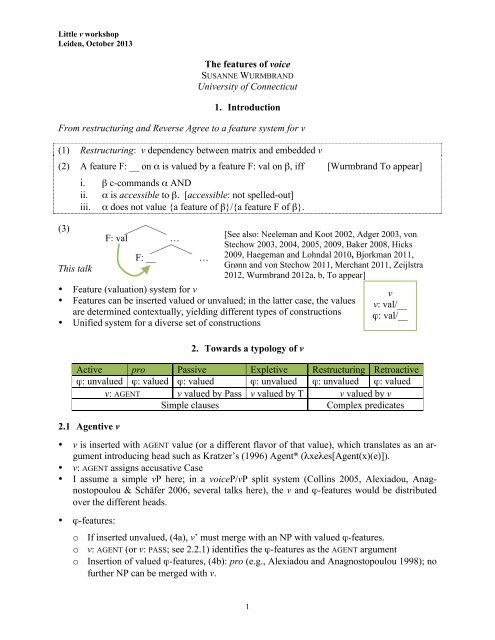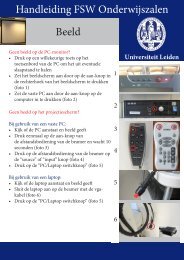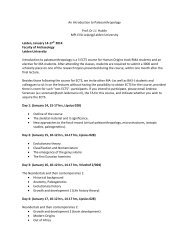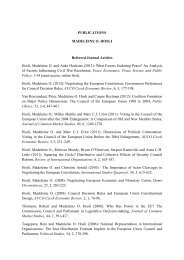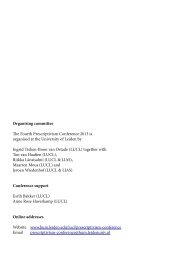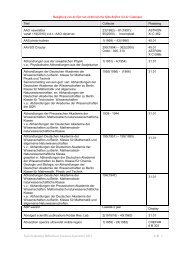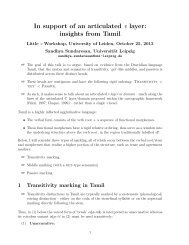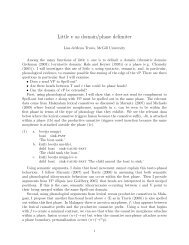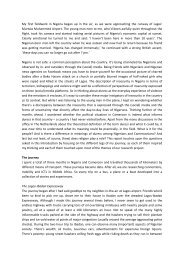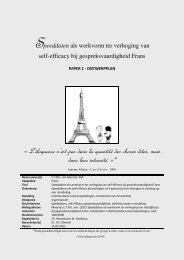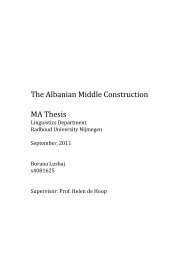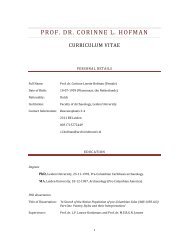Susi Wurmbrand - O
Susi Wurmbrand - O
Susi Wurmbrand - O
Create successful ePaper yourself
Turn your PDF publications into a flip-book with our unique Google optimized e-Paper software.
Little v workshop<br />
Leiden, October 2013<br />
The features of voice<br />
SUSANNE WURMBRAND<br />
University of Connecticut<br />
1. Introduction<br />
From restructuring and Reverse Agree to a feature system for v<br />
(1) Restructuring: v dependency between matrix and embedded v<br />
(2) A feature F: __ on α is valued by a feature F: val on β, iff [<strong>Wurmbrand</strong> To appear]<br />
i. β c-commands α AND<br />
ii. α is accessible to β. [accessible: not spelled-out]<br />
iii. α does not value {a feature of β}/{a feature F of β}.<br />
(3) 3<br />
F: val …<br />
3<br />
F: __ …<br />
This talk<br />
[See also: Neeleman and Koot 2002, Adger 2003, von<br />
Stechow 2003, 2004, 2005, 2009, Baker 2008, Hicks<br />
2009, Haegeman and Lohndal 2010, Bjorkman 2011,<br />
Grønn and von Stechow 2011, Merchant 2011, Zeijlstra<br />
2012, <strong>Wurmbrand</strong> 2012a, b, To appear]<br />
• Feature (valuation) system for v<br />
• Features can be inserted valued or unvalued; in the latter case, the values<br />
are determined contextually, yielding different types of constructions<br />
• Unified system for a diverse set of constructions<br />
2. Towards a typology of v<br />
v<br />
v: val/__<br />
ϕ: val/__<br />
Active pro Passive Expletive Restructuring Retroactive<br />
ϕ: unvalued ϕ: valued ϕ: valued ϕ: unvalued ϕ: unvalued ϕ: valued<br />
v: AGENT v valued by Pass v valued by T v valued by v<br />
Simple clauses<br />
Complex predicates<br />
2.1 Agentive v<br />
• v is inserted with AGENT value (or a different flavor of that value), which translates as an argument<br />
introducing head such as Kratzer’s (1996) Agent* (λxeλes[Agent(x)(e)]).<br />
• v: AGENT assigns accusative Case<br />
• I assume a simple vP here; in a voiceP/vP split system (Collins 2005, Alexiadou, Anagnostopoulou<br />
& Schäfer 2006, several talks here), the v and ϕ-features would be distributed<br />
over the different heads.<br />
• ϕ-features:<br />
o If inserted unvalued, (4a), v’ must merge with an NP with valued ϕ-features.<br />
o v: AGENT (or v: PASS; see 2.2.1) identifies the ϕ-features as the AGENT argument<br />
o Insertion of valued ϕ-features, (4b): pro (e.g., Alexiadou and Anagnostopoulou 1998); no<br />
further NP can be merged with v.<br />
1
(4) a. Active v b. pro<br />
vP<br />
vP<br />
3 3<br />
NP v’ v VP<br />
ϕ: val 1 3 v: AGENT …<br />
v VP ϕ: val 1<br />
v: AGENT …<br />
ϕ: ___<br />
v<br />
v: AGENT<br />
ϕ: val 1 /val 1<br />
1 = AGENT<br />
2.2 Unvalued v<br />
• v is inserted unvalued; value is determined contextually<br />
• Passive, expletive: v valued in situ by higher head<br />
• Restructuring, retroactive: v valued after incorporation (section 3)<br />
2.2.1 Passive v<br />
• PassP: functional head introducing the passive auxiliary (which values v+V as participle)<br />
• Pass: values v feature v: PASS, which translates as a head introducing an existentially closed<br />
agent argument<br />
• Legate (2010, 2012): lexically valued ϕ-features on v correspond to the features of an (implicit<br />
or oblique) agent<br />
• v: PASS identifies the ϕ-features on v as an implicit AGENT argument<br />
• Only v: AGENT assigns accusative Case; object must move into the Agree domain of T (NOM)<br />
(5) ϕ: valued PassP Phase<br />
3<br />
vP<br />
3<br />
Pass<br />
v: PASS<br />
vP<br />
3<br />
v VP v VP<br />
v: ___ … v: PASS …<br />
ϕ: val 1 ϕ: val 1<br />
v<br />
v: PASS<br />
ϕ: val 1<br />
1 = AGENT<br />
2.2.2 Explective v 1<br />
• ϕ-features are inserted unvalued<br />
• Object does not get ACC from v (not v: AGENT); moves to Spec,vP (phase edge)<br />
• Object values v’s ϕ-features (no thematic relation is established)<br />
• T values v with a default value; v: EXPL (Schäfer 2008)<br />
(6) ϕ: unvalued 3<br />
T<br />
vP Phase<br />
3<br />
v’<br />
3<br />
OBJ 2 v’<br />
3<br />
v VP v VP<br />
v: ___ … v: T≈EXPL …<br />
ϕ: ___ ϕ: val 2<br />
v<br />
v: EXPL<br />
ϕ: val 2<br />
2 = THEME<br />
1 This part has been developed in discussions with Marcel Pitteroff.<br />
2
(7) a. The door opened Inchoative, anti-causative, absolute construction<br />
b. Die Vase zerbrach<br />
The vase broke<br />
Brazilian Portuguese (Negrão and Viotti 2010)<br />
• Absolute construction: no se (sometimes impossible), non-agentive, non-stative; not middle<br />
• Examples (all active and without se): the carpet finished, the train missed, the program installed,<br />
the subject was treating, a serve erred, the garden destroyed, the house sold<br />
(8) a. A Maria impregnou a blusa com/de perfume<br />
The Mary scented the blouse with/of perfume<br />
‘Mary scented the blouse’<br />
b. A blusa foi impregnada com/de perfume passive<br />
The blouse was sented with/of perfume<br />
c. A blusa se impregnou com/de perfume middle<br />
The blouse SE sented with/of perfume<br />
d. A blusa impregnou toda *com/de perfume anti-causative<br />
The blouse scented all *with/of perfume<br />
[OK if middle with dropped se; R. Lacerda, p.c.]<br />
Excluded configurations?<br />
Passive ? Expletive ?<br />
ϕ: valued ϕ: unvalued ϕ: unvalued ϕ: valued<br />
v valued by Pass v valued by Pass v valued by T v valued by T<br />
• PassP and unvalued ϕ-features:<br />
o Object moves to Spec,vP and values v’s ϕ-features (ϕ: val 2 ); Pass values v (v:<br />
PASS); v: PASS identifies the object as the agent argument Theta mismatch<br />
o Subject merges in Spec,vP and values v’s ϕ-features (ϕ: val 1 ); Pass values v (v:<br />
PASS); v: PASS identifies the subject as the agent argument, but semantics of pass<br />
requires an existentially closed agent argument; conflicts with overt NP.<br />
• No PassP, but valued ϕ-features on v: *[v: T=EXPL, ϕ: val]; ϕ-features cannot be identified<br />
(need an explicit [AGENT] or implicit [PASS] argument introducing feature).<br />
2.2.3 Complex predicates<br />
(9) 3 Restructuring ≈ voice dependency<br />
v<br />
VP<br />
v: val 3<br />
V vP Phase<br />
try/let 3<br />
v<br />
ϕ: val/__<br />
VP<br />
…<br />
v: ___<br />
3
3. Restructuring<br />
3.1 Summary of proposal<br />
(10) 3<br />
v VP Phase<br />
v: val 3 Restructuring involves a v<br />
V vP SOD Restructuring vP is a (potential) phase<br />
2 2 Incorporation of v and phase extension<br />
{v } V {v} VP Different spell-out options for incorporated v<br />
v: ___ …<br />
ϕ: val/__<br />
• Dynamic phase approach: The highest projection of a cyclic domain is a phase (Bobaljik and<br />
<strong>Wurmbrand</strong> 2005, 2013, den Dikken 2007, 2012a, b, Bošković To appear, <strong>Wurmbrand</strong><br />
2013a, b); relevant here: [ Phase {AspP/PassP} {vP} VP ]<br />
• Phase extension: Following den Dikken (2007), among others, phasehood is extended by<br />
head-movement; incorporation of the embedded v extends the embedded vP phase to the matrix<br />
VP and the embedded vP becomes a spell-out domain [SOD].<br />
• Movement has to go through matrix Spec,VP—anti-reconstruction derived (without<br />
‘agreement domains’; Bobaljik and <strong>Wurmbrand</strong> 2005)<br />
(11) a. weil er alle Fenster vergessen hat [ t OBJ zu schließen]<br />
since he all windows (ACC) forgotten has [ t OBJ to close]<br />
‘since he forgot to close all the windows’<br />
∀ » forget; *forget » ∀<br />
b. John-wa subeto-no ringo-o tabe-wasure-ta<br />
John-TOP all-GEN apple-ACC eat-forget-PAST<br />
‘John forgot to eat all the apples.’<br />
3.2 Restructuring as VP+ complementation<br />
Long passive<br />
∀ » forget; *forget » ∀<br />
• Embedded restructuring complement lacks a functional domain (<strong>Wurmbrand</strong> 2001 et seq.)<br />
• Embedded object is dependent on the voice properties of the matrix predicate<br />
(12) a. dass der Traktor und der Lastwagen zu reparieren versucht wurden German<br />
that [the tractor and the truck].NOM to repair tried were.PASS.PL<br />
‘that they tried to repair the tractor and the truck’<br />
b. Aneuk agam nyan geu-ci (*geu-)peuréksa lé dokto Acehnese<br />
child male DEM 3.POL-try (*3.POL-)diagnose by doctor<br />
Lit. ‘The child was tried to be diagnosed by the doctor.’<br />
‘The doctor tried to diagnose the child.’ [Legate 2012: 501]<br />
c. naqaru.un i t.um.uting ni yumin ku bawaq Mayrinax Atayal<br />
finish.PV LNK beat.AV.beat GEN Yumin NOM pig<br />
Lit. ‘The pigs were finished to be beaten by Yumin.’<br />
‘Yumin finished beating/killing the pigs.’ [Chen 2010: 5]<br />
4
Reasons for the presence of v in restructuring<br />
• Association of embedded predicate with a subject (Chierchia 1984—meaning postulates; can<br />
we do better?)<br />
• Voice-marking on the embedded predicate in many languages<br />
• Transitivity mismatches of matrix and embedded predicates<br />
• Difference between default voice and voice matching languages<br />
(13) a. Ma’a’ñao i pätgun ha-taitai esti na lepblu Chamorro<br />
NPL.RL.IN.afraid the child 3SG.RL.TR-read this LNK book<br />
‘The child is afraid to read this book.’<br />
[Chung 2004: 203; (5a)]<br />
b. Chinägi dinispensa si Carmen gias Maria Chamorro<br />
NPL.R.IN.PASS.try NPL.RL.IN.PASS.forgive DET Carmen OBL Maria<br />
Lit. ‘Carmen was tried to be forgiven by Maria.’<br />
‘Maria tried to forgive Carman.’<br />
[Chung 2004: 219; (31a)]<br />
c. Iliskinun-ku bunbun-a tu baliv-un Isbukun Bunun<br />
want.PV-1SG.ACC banana-that.NOM TU buy-PV<br />
Lit. ‘The bananas are wanted to be bought by me.’<br />
‘I wanted to buy the bananas.’ [Wu 2013: 40]<br />
(14) a. *Tinituhun ha-lalatdi si Dolores i famagu’un<br />
NPL.RL.IN.PASS.begin 3SG.RL.TR-scold Dolores the children<br />
‘Dolores began to scold the children’<br />
[Chung 2004: 219; (32a)]<br />
b. *Tinituhun kumati i pätgun<br />
NPL.RL.IN.PASS.begin NPL.RL.IN.cry the child<br />
‘The child began to cry.’<br />
[Chung 2004: 219; (32b)]<br />
c. *Ha-hähassu si Carmen binisita i biha<br />
3SG.RL.TR-think.PROG Carmen NPL.RL.IN.PASS.visit the old.lady<br />
‘Carmen is thinking of visiting the old lady.’<br />
[Chung 2004: 222; (37a)]<br />
d. *Kao ha-ayuda man-sinedda’ i famagu’un ni chi’lu-hu?<br />
Q 3SG.RL.TR-help PL.RL.IN-PASS.find the children OBL sibling-1SG<br />
‘Did my brother help find the children?’<br />
[Chung 2004: 222; (37b)]<br />
But: restructuring complement lacks a subject and accusative Case<br />
(15) a. Es wurde versucht [PRO IMPL sich IMPL den Fisch mit Streifen vorzustellen]<br />
It was tried [PRO IMPL SELF IMPL the fish.ACC with stripes to-imagine]<br />
‘People tried to imagine what the fish would look like with stripes.’<br />
b. *weil sich der Fisch mit Streifen vorzustellen versucht wurde RI<br />
since SELF the fish.NOM with stripes to-imagine tried was<br />
‘since somebody tried to recall the image of the fish’<br />
c. weil [ sich den Fisch mit Streifen vorzustellen ] versucht wurde NRI<br />
since [ SELF the fish.ACC with stripes to-imagine ] tried was<br />
‘since somebody tried to recall the image of the fish’<br />
5
3.3 Restructuring v<br />
• Incorporation and spell-out<br />
(16) VP1 Phase<br />
3<br />
restructuring NP.OBJ V’<br />
ϕ unvalued 3<br />
vP V vP SOD<br />
2 2 2<br />
v VP2 v V1 v VP2<br />
v: ___ v: ___ v: ___ @<br />
ϕ: ___ ϕ: ___ ϕ: ___ V t Obj<br />
• Restructuring: v, ϕ unvalued<br />
• No ACC, no embedded subject<br />
(v: ___ cannot associate an NP<br />
with a theta-role at this point)<br />
• v incorporates into matrix V<br />
• phase extension to VP1, edge<br />
movement (anti-reconstructions)<br />
PF copy choice: {v} {v} spell-out of v postponed (Chamorro etc.)<br />
{v} {v} default value: Atayal—AV (see below);<br />
German—infinitive; Acehnese—bare V<br />
(17) Active matrix predicate vP<br />
3<br />
NP 1 v’<br />
3 ϕ: val 3<br />
v VP1 v VP1<br />
v: AGENT 3 v: AGENT 3<br />
ϕ: ___ NP.OBJ ϕ: val 1<br />
ACC<br />
V’<br />
3<br />
NP.OBJ<br />
ACC<br />
V’<br />
3<br />
V vP V<br />
2 2<br />
vP<br />
v V1 v V1<br />
v: AGENT v: AGENT<br />
ϕ: ___ ϕ: val 1<br />
LF: NP 1 is the agent of both matrix and embedded v<br />
(18) Passiv matrix predicate PassP<br />
3<br />
Pass vP<br />
3 v: PASS 3<br />
v VP1 v VP1<br />
v: ___ 3 v: PASS 3<br />
ϕ: val 1 NP.OBJ ϕ: val 1<br />
ACC<br />
V’<br />
3<br />
NP.OBJ<br />
ACC<br />
V’<br />
3<br />
V vP V<br />
2 2<br />
vP<br />
v V1 v V1<br />
v: ___ v: PASS<br />
ϕ: val 1 ϕ: val 1<br />
<br />
<br />
LF: 1 is the agent of both matrix and embedded v<br />
PF: in voice matching languages both v’s spell out as PASSIVE<br />
6
3.4 Further evidence<br />
v incorporation<br />
• Complex head approaches to restructuring: V—V formation (Geach 1970, Steedman 1985,<br />
Haider 1993, 2003, Hinrichs and Nakezawa 1994, Butt 1995, Kiss 1995, Bouma and Noord<br />
1997, S. Müller 1999, 2002, 2006, Meurers 2000, Saito and Hoshi 2000, Williams 2003)<br />
• Separation of the two verbs as in VP-fronting<br />
(19) [Zu reparieren ] VP wurden nur blaue Autos vergessen<br />
[To repair ] VP were only blue cars forgotten<br />
‘They only forgot to repair blue cars.’ [<strong>Wurmbrand</strong> 2007: 264]<br />
Default voice in Mayrinax Atayal<br />
(20) a. naqaru.un i t.um.uting ni yumin ku bawaq [Chen 2010: 5]<br />
finish.PV LNK beat.AV.beat GEN Yumin NOM pig<br />
Lit. ‘The pigs were finished to be beaten by Yumin.’<br />
‘Yumin finished beating/killing the pigs.’<br />
b. m.naqru i t.um.uting cu bawaq i yumin [Chen 2010: 7]<br />
AV.finish LNK beat.AV.beat ACC pig NOM Yumin<br />
‘Yumin is finishing beating/killing pigs.’<br />
c. *naqaru.un i tuting.un ni yumin ku bawaq [Chen 2010: 11]<br />
finish.PV LNK beat.PV GEN Yumin NOM pig<br />
d. *m.naqru i tuting.un i yumin cu bawaq [Chen 2010: 11]<br />
AV.finish LNK beat.PV NOM Yumin ACC pig<br />
• Object A’-extraction: only possible if V is marked PV<br />
• Restructuring: object A’-extraction possible, despite AV of embedded V.<br />
(21) a. nanuan ku tuting.un ni yumin Mayrinax Atayal<br />
what NOM beat.PV GEN Yumin<br />
‘What is Yumin beating/killing?’ [Chen 2010: 8]<br />
b. *nanuan ku t.um.uting i yumin<br />
what NOM beat.AV.beat NOM Yumin<br />
c. nanuan ku naqaru.un i t.um.uting ni yumin<br />
what NOM finish.PV LNK beat.AV.beat GEN Yumin<br />
‘What did Yumin finish beating/killing?’<br />
d. *nanuan ku siwal.an ni tali i t.um.uting i yumin<br />
what NOM allow.LV GEN Tali COMP beat.AV.beat NOM Yumin<br />
• Clitics: there are no ACC clitics; in simple clauses, object clitics are only possible when they<br />
are NOM, which in turn requires that the verb occurs in PV<br />
• In restructuring contexts (with clitics), the lower verb must still occur in AV.<br />
7
3.5 ‘Passive’ restructuring and retroactive v<br />
German let ‘passive’ (with Marcel Pitteroff)<br />
(22) a. Ich ließ ihn feuern<br />
I let him.ACC fire.INF<br />
‘I let him fire (something).’<br />
‘I let (someone) fire him.’ ‘He is being fired.’<br />
b. Ich ließ ihn vom Chef feuern<br />
I let him.ACC by.the boss fire<br />
‘I let him be fired by the boss.’ ‘I let the boos fire him.’<br />
(23) VP1 Phase<br />
3<br />
restructuring NP.OBJ V’<br />
ϕ: valued 3<br />
vP V vP SOD<br />
2 2 2<br />
v VP2 {v} V1 {v} VP2<br />
v: ___ v: ___ let @<br />
ϕ: val 1 ϕ: val 1 V t Obj<br />
• Restructuring v; ϕ valued<br />
• No ACC (?), no embedded nonoblique<br />
subject<br />
• v incorporates into matrix V<br />
• phase extension to VP1<br />
• edge movement of object<br />
(24) vP<br />
3<br />
NP 2 v’<br />
3 ϕ: val 2 3<br />
v VP1 v VP1<br />
v: AGENT 3 v: AGENT 3<br />
ϕ: ___ NP.OBJ ϕ: val 2<br />
ACC<br />
V’<br />
3<br />
NP.OBJ<br />
ACC<br />
V’<br />
3<br />
V vP V<br />
2 2<br />
vP<br />
v V1 {v} V1<br />
v: AGENT v: AGENT let<br />
ϕ: val 1 ϕ: val 1<br />
<br />
LF: NP 2 is the agent of the matrix predicate, but “1” is the agent of the embedded predicate<br />
Retroactive infinitives/gerunds—preliminary<br />
(25) a. Your hair needs/wants/requires cutting. [Hantson 1984: 95]<br />
% b. This matter needs handling carefully by an expert. “<br />
(26) a. Ta kniha potřebuje přeložit (zkušeným překladatelem) Czech<br />
that book needs translate.INF (experienced translator.INSTR)<br />
‘That book needs translating by an experienced translator.’ [Dotlačil & Šimík 2013: (6)]<br />
b. Ta skladba potřebuje zahrát (??záměrně) velmi pomalu<br />
that song needs play.INF (??intentionally) very slowly<br />
‘It is desirable to play this song intentionally very slowly.’ [D&Š 2013: (23a)]<br />
8
c. Ta kniha byla čtena (záměrně) velmi pomalu<br />
that book was read.PASS (intentionally) very slowly<br />
‘The book was read intentionally very slowly.’<br />
[D&Š 2013: (23b)]<br />
d. Karel potřebuje učesat<br />
Karel needs comb.INF<br />
‘Karel’s hair needs combing.’ [possibly by Karel]<br />
e. Karel byl učesán<br />
Karel was comb.PASS<br />
‘Karel’s hair was combed.’ [Necessarily not by Karel]<br />
[D&Š 2013: (24a)]<br />
[D&Š 2013: (24b)]<br />
<br />
Speaker variation and mixed agent properties<br />
• Embedded predicate: (23)—ϕ: valued restructuring v<br />
• Object movement (Dotlačil & Šimík 2013); object associates with another theta-role in the<br />
matrix predicate (some applicative/possessor/benefactive/source meta theta-role)<br />
• APPL v values embedded v; this allows the association of the ϕ-features with an agent-like<br />
interpretation (e.g., allowing an agent-like oblique)<br />
• But: the embedded v is not v: AGENT, and hence is not compatible with properties that are<br />
indicative of an agentive v (such as agentive adverbs); and v: APPL does not assign ACC<br />
• needs washed construction: by phrase also controversial (Brassil 2009, Whitman 2010);<br />
http://microsyntax.sites.yale.edu/needs-washed.<br />
(27) Raising/Control ApplP<br />
3<br />
NP.OBJ Appl’<br />
3 ϕ: val 2 3<br />
Appl VP1 Appl VP1<br />
v: APPL 3 v: APPL 3<br />
ϕ: ___ NP.OBJ ϕ: val 2 t OBJ V’<br />
3<br />
V’<br />
3<br />
V vP V<br />
2 2<br />
vP<br />
v V1 {v} V1<br />
v: APPL need v: APPL need<br />
ϕ: val 1 ϕ: val 1<br />
• Brazilian Portuguese: ϕ-valued restructuring or embedded expletive v?<br />
(28) a. A Maria deixou a criança vacinar<br />
The Mary let the child vaccinate<br />
‘Mary let the child be vaccinated (by someone else).’<br />
[R. Lacerda, p.c.]<br />
b. A criança vacinou expletive v<br />
The child vaccinated<br />
‘The child was vaccinated.’<br />
[R. Lacerda, p.c.]<br />
c. A Maria deixou a criança vacinar *pelo/com o médico novo<br />
The Mary let the child vaccinate *by.the/with the doctor new<br />
‘Mary let the child be vaccinated by the new doctor.’<br />
[R. Lacerda, p.c.]<br />
9
4. Conclusion and further issues<br />
Not covered<br />
• Different types of passive, middles…<br />
• Directions to pursue: configurations given in section 2.2.2 under Excluded configurations?<br />
• Distribution of possible combinations (e.g., why is the class of predicates that allow an anticausative/absolute<br />
construction in BP larger than in English, why are retroactive complements<br />
so restricted? etc. etc.)<br />
Active pro Passive Expletive Restructuring Retroactive<br />
ϕ: unvalued ϕ: valued ϕ: valued ϕ: unvalued ϕ: unvalued ϕ: valued<br />
v: AGENT v: AGENT v valued by Pass v valued by T v valued by v v valued by v<br />
Simple clause<br />
Complex predicate<br />
• Two feature sets for v<br />
• Values determined by lexical properties of v and the syntactic context<br />
• System brings together several (odd) constructions<br />
5. References<br />
Adger, David. 2003. Core Syntax: A Minimalist Approach. Oxford, England: Oxford UP.<br />
Alexiadou, Artemis, and Elena Anagnostopoulou. 1998. Parametrizing AGR: Word order, V-<br />
movement and EPP-checking. Natural Language and Linguistic Theory 16.3:491-539.<br />
Baker, Mark. 2008. The syntax of agreement and concord. Cambridge: Cambridge University<br />
Press.<br />
Bjorkman, Bronwyn Alma Moore. 2011. BE-ing Default: The Morphosyntax of Auxiliaries.<br />
Doctoral dissertation, MIT, Cambridge, MA.<br />
Bobaljik, Jonathan D., and <strong>Susi</strong> <strong>Wurmbrand</strong>. 2005. The domain of agreement. Natural Language<br />
and Linguistic Theory 23.4:809-865.<br />
Bobaljik, Jonathan D., and <strong>Susi</strong> <strong>Wurmbrand</strong>. 2013. Suspension across domains. In Distributed<br />
Morphology Today: Morphemes for Morris Halle, ed. by Ora Matushansky and Alec<br />
Marantz, 185-198. Cambridge, MA: MIT Press.<br />
Bošković, Željko. To appear. Now I’m a phase, now I’m not a phase: On the variability of<br />
phases with extraction and ellipsis. Linguistic Inquiry.<br />
Bouma, Gosse, and Gertjan van Noord. 1997. Dutch verb clustering without verb clusters. In<br />
Specifying syntactic structures, ed. by Patrick Blackburn and Maarten De Rijke, 213-243.<br />
Stanford, Calif: Center Study Language and Information.<br />
Brassil, Dan. 2009. A middle voice in Appalachian English. Paper presented at the LSA Annual<br />
Meeting.<br />
Butt, Miriam. 1995. The Structure of Complex Predicates in Urdu. Stanford, Calif: CSLI<br />
Publications.<br />
Chen, Tingchun. 2010. Restructuring in Mayrinax Atayal. B. Arts Honours Thesis. Montréal:<br />
McGill University.<br />
10
Chierchia, Gennaro. 1984. Topics in the syntax and semantics of infinitives and gerunds.<br />
Doctoral dissertation, University of Massachusetts, Amherst.<br />
Chung, Sandra. 2004. Restructuring and verb-initial order in Chamorro. Sytnax 7.3:199-233.<br />
Collins, Chris. 2005. A smuggling approach to the passive in English. Syntax 8.2:81-120.<br />
Dikken, Marcel den. 2007. Phase Extension: Contours of a Theory of the Role of Head<br />
Movement in Phrasal Extraction. Theoretical Linguistics 33.1:1-41.<br />
Dikken, Marcel den. 2012a. On feature interpretability and inheritance. Ms., City University.<br />
New York.<br />
Dikken, Marcel den. 2012b. The Phase Impenetrability Condition and successive cyclicity: A<br />
reconsideration. Ms., City University. New York.<br />
Dotlačil, Jakub, and Radek Šimík. 2013. Peeling, structural Case, and Czech retroactive<br />
infinitives. In Formal description of Slavic Languages: The ninth conference, ed. by Uwe<br />
Junghanns, Dorothee Fehrmann, Denisa Lenertová and Hagen Pitsch: Peter Lang.<br />
Geach, Peter Thomas. 1970. A program for syntax. Synthese 22:3–17.<br />
Grønn, Atle, and Arnim von Stechow. 2011. The temporal organisation of indicative<br />
conditionals. Ms. Tübingen.<br />
Haegeman, Liliane, and Terje Lohndal. 2010. Negative Concord and (Multiple) Agree: A Case<br />
Study of West Flemish. Linguistic Inquiry 41.2:181-211.<br />
Haider, Hubert. 1993. Deutsche Syntax—Generativ. Tübingen: Gunter Narr Verlag.<br />
Haider, Hubert. 2003. V-clustering and clause union: Causes and effects. In Verb constructions<br />
in German and Dutch, ed. by Pieter Seuren and Gerard Kempen, 91-126.<br />
Amsterdam/Philadelphia: John Benjamins.<br />
Hantson, André. 1984. Towards an analysis of retroactive gerunds. In Sentential<br />
complementation: Proceedings of the international conference held at UFSAL, Brussels<br />
(June 1983), ed. by Wim de Geest and Yvan Putsey, 95-103. Dordrecht: Foris<br />
Publications.<br />
Hicks, Glyn. 2009. The derivation of anaphoric relations. Amsterdam/Philadelphia: John<br />
Benjamins.<br />
Hinrichs, Erhard, and Tsuneko Nakezawa. 1994. Linearizing finite AUX in German verbal<br />
complexes. In German in Head-Driven Phrase Structure Grammar, ed. by John<br />
Nerbonne, Klaus Netter and Carl Pollard, 11-38. Stanford, Calif: CSLI Publications.<br />
Kiss, Tibor. 1995. Infinite Komplementation: Neue Studien zum deutschen Verbum infinitum.<br />
Tübingen: Max Niemeyer Verlag.<br />
Kratzer, Angelika. 1996. Severing the external argument from its verb. In Phrase structure and<br />
the lexicon, ed. by Johan Rooryck and Laurie Zaring, 109-137. Dordrecht: Kluwer<br />
Academic Publishers.<br />
Legate, Julie Anne. 2010. The structure of agents in implicit passives. Talk given at the 41st<br />
annual meeting of the North East Linguistics Society, Philadelphia.<br />
Legate, Julie Anne. 2012. Subjects in Acehnese and the nature of the passive. Language<br />
88.3:495-525.<br />
Merchant, Jason. 2011. Aleut case matters. In Pragmatics and Autolexical Grammar: In honor of<br />
Jerry Sadock, ed. by Etsuyo Yuasa Yuasa, Tista Bagchi and Katharine P. Beals, 382-411.<br />
Amsterdam: John Benjamins.<br />
Meurers, Walt Detmar. 2000. Lexical generalizations in the syntax of German non-finite<br />
constructions. Doctoral dissertation, University of Tübingen.<br />
11
Müller, Stefan. 1999. Deutsche Syntax deklarativ: Head-Driven Phrase Structure Grammar für<br />
das Deutsche. Tübingen: Max Niemeyer Verlag.<br />
Müller, Stefan. 2002. Complex predicates: Verbal complexes, resultatitve constructions and<br />
particle verbs in German. Stanford, Calif: CSLI Publications.<br />
Müller, Stefan. 2006. Complex predicates. In Encyclopedia of Language and Linguistics. 2nd<br />
Edition, ed. by Keith Brown, 697–704. Oxford: Elsevier.<br />
Neeleman, Ad, and Hans van de Koot. 2002. The configurational matrix. Linguistic Inquiry<br />
33.4:529-574.<br />
Negrão, Esmeralda, and Evani Viotti. 2010. A estrutura sintática das sentenças absolutas no<br />
português brasileiro. Revista Linguística da ALFAL:37-58.<br />
Saito, Mamoru, and Hiroto Hoshi. 2000. The Japanese light verb construction and the Minimalist<br />
Program. In Step by step: Essays on minimalist syntax in honor of Howard Lasnik, ed. by<br />
Roger Martin, David Michaels and Juan Uriagereka, 261-295. Cambridge, MA: MIT<br />
Press.<br />
Schäfer, Florian. 2008. The syntax of (anti-)causatives: External arguments in change-of-state<br />
contexts. Amsterdam: John Benjamins.<br />
Steedman, Mark. 1985. Dependency and coördination in the grammar of Dutch and English.<br />
Language 61.3:523-568.<br />
Whitman, Neal. 2010. Special Needs. In Literal-Minded.<br />
[http://literalminded.wordpress.com/2010/01/29/special-needs/].<br />
Williams, Edwin. 2003. Representation theory. Cambridge, MA: MIT Press.<br />
Wu, Hsiao-hung Iris. 2013. Restructuring and Clause Structure in Isbukun Bunun. Oceanic<br />
Linguistics 52.1:36-52.<br />
<strong>Wurmbrand</strong>, <strong>Susi</strong>. 2001. Infinitives: Restructuring and clause structure. Berlin/New York:<br />
Mouton de Gruyter.<br />
<strong>Wurmbrand</strong>, <strong>Susi</strong>. 2007. How complex are complex predicates? Syntax 10:243-288.<br />
<strong>Wurmbrand</strong>, <strong>Susi</strong>. 2013a. QR and selection: Covert evidence for phasehood. In Proceedings of<br />
the North Eastern Linguistics Society Annual Meeting 42, ed. by Stefan Keine and<br />
Shayne Sloggett, 277-290. Amherst: University of Massachusetts, GLSA.<br />
<strong>Wurmbrand</strong>, <strong>Susi</strong>. 2013b. Stripping and topless complements. Ms., University of Connecticut.<br />
Storrs.<br />
<strong>Wurmbrand</strong>, <strong>Susi</strong>. To appear. The Merge Condition: A syntactic approach to selection. In<br />
Minimalism and Beyond: Radicalizing the interfaces, ed. by Peter Kosta, Lilia Schürcks,<br />
Steven Franks and Teodora Radev-Bork. Amsterdam: John Benjamins.<br />
Zeijlstra, Hedde. 2012. There is only one way to Agree. The Linguistic Review 29.3:491–539.<br />
susanne.wurmbrand@uconn.edu<br />
http://wurmbrand.uconn.edu<br />
12


